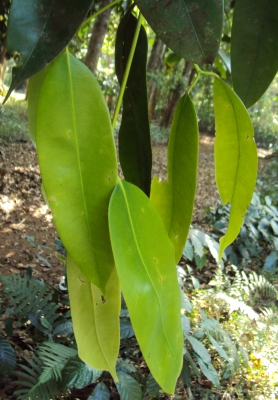Poeciloneuron indicum
Bedd.
Clusiaceae
Common Name:
General Information
Poeciloneuron indicum is an evergreen tree that can grow 36 metres or more tall. The bole is buttressed, often with stilt roots.
The tree is harvested from the wild for its timber.
Known Hazards
None known
Botanical References
Range
E. Asia - southern India.
Habitat
A canopy tree in evergreen forests at elevations from 300 - 900 metres[
].
Properties
| Other Uses Rating |      |
| Habit | Evergreen Tree |
| Height | 30.00 m |
| Cultivation Status | Wild |
Cultivation Details
A plant of the wet tropics, where it is found at elevations from 300 - 900 metres. It grows best in areas where annual daytime temperatures are within the range 30 - 37°c, but can tolerate 13 - 42°c[
]. It can survive temperatures down to about 5°c[
]. It prefers a mean annual rainfall in the range 4,000 - 6,000mm, but tolerates 2,000 - 9,000mm[
].
The tree is shade tolerant in the early stages, but strongly light demanding later[
]. Grows best in a fertile, loamy to clay soil[
]. Prefers a pH in the range 5 - 6, tolerating 4 - 6.9[
].
The tree is more or less gregarious, seeds profusely and reproduces admirably, making it a useful tree in high forest for timber purposes[
146- Title
- A Manual of Indian Timbers.
- Publication
-
- Author
- Gamble. J. S.
- Publisher
- Bishen Singh Mahendra Pal Singh
- Year
- 1972
- ISBN
- -
- Description
- First written in the 19th century, but still a classic, giving a lot of information on the uses and habitats of Indian trees. Not for the casual reader.
].
Coppices well, making it an excellent species for short-term coppice rotation as a fuel crop[
146- Title
- A Manual of Indian Timbers.
- Publication
-
- Author
- Gamble. J. S.
- Publisher
- Bishen Singh Mahendra Pal Singh
- Year
- 1972
- ISBN
- -
- Description
- First written in the 19th century, but still a classic, giving a lot of information on the uses and habitats of Indian trees. Not for the casual reader.
].
Edible Uses
None known
Medicinal
None known
Other Uses
The heartwood is dark red; not clearly demarcated from the lighter-coloured sapwood. There are occasional very short, fine, white, concentrically running lines, especially in the sapwood[
146- Title
- A Manual of Indian Timbers.
- Publication
-
- Author
- Gamble. J. S.
- Publisher
- Bishen Singh Mahendra Pal Singh
- Year
- 1972
- ISBN
- -
- Description
- First written in the 19th century, but still a classic, giving a lot of information on the uses and habitats of Indian trees. Not for the casual reader.
]. The wood is very hard and heavy. It is used to make rice-pounders and, with its excellent qualities, endeavours have been made to introduce the timber as a sleeper and paving-block wood[
146- Title
- A Manual of Indian Timbers.
- Publication
-
- Author
- Gamble. J. S.
- Publisher
- Bishen Singh Mahendra Pal Singh
- Year
- 1972
- ISBN
- -
- Description
- First written in the 19th century, but still a classic, giving a lot of information on the uses and habitats of Indian trees. Not for the casual reader.
].
The wood makes a good fuel[
146- Title
- A Manual of Indian Timbers.
- Publication
-
- Author
- Gamble. J. S.
- Publisher
- Bishen Singh Mahendra Pal Singh
- Year
- 1972
- ISBN
- -
- Description
- First written in the 19th century, but still a classic, giving a lot of information on the uses and habitats of Indian trees. Not for the casual reader.
].
Propagation
Seed -
If you have any useful information about this plant, please leave a comment. Comments have to be approved before they are shown here.




 Useful Tropical Plants Database 2014 by
Ken Fern,
web interface by
Ajna Fern
with help from
Richard Morris.
Useful Tropical Plants Database 2014 by
Ken Fern,
web interface by
Ajna Fern
with help from
Richard Morris.